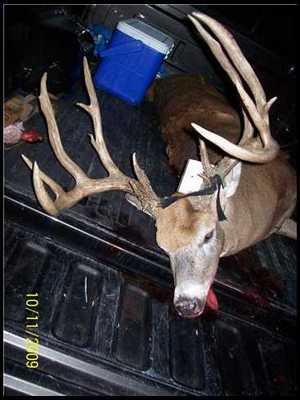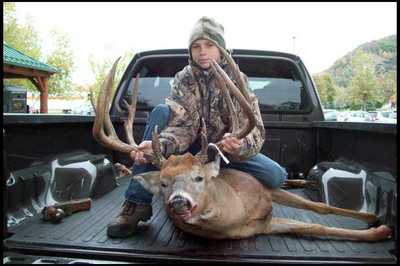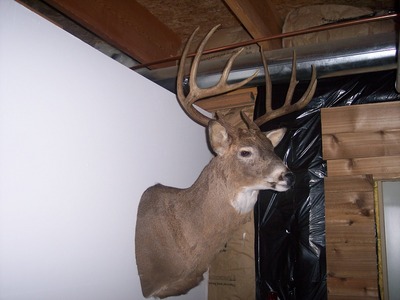Furniture bags.
My father used to work for a furniture manufacture. He’d cut them on two of the three seams and tape them down.
Posts: 35
June 3, 2010 at 4:41 pm
#81888
Furniture bags.
My father used to work for a furniture manufacture. He’d cut them on two of the three seams and tape them down.
Quote:
Quote:
wow.
14 members and 44 guests online.
must be turkey season.

Or mushroom season



So how much did they grow since the first time you found them this year.
I too kicked up a nice buck this morning shroom hunting. Couldn’t get a picture with digital though. He was more interested in putting as much distance between us as he could versus smiling pretty for the camera.
Let us know how much those shrooms grow over the next week gut. I’ll bet if we get a shot of rain this weekend most of them will at least double if not triple in size next week 
Morchella growth………..Do morels grow?
A simple concept yet complex topic morel hunters have debated for years and will continue to debate for years to come. I’ve spent countless hours in the woods chasing the ever so elusive morel mushroom. I’ve hunted with late Larry Lonik, attended countless festivals throughout the midwest and read any article I can find on morel mushrooms stretching back over the past 25+ years. I’ve entertained various authors from the Wisconsin State Journal, Milwaukee Journal, Hearld Independent, Platteville Journal, and Telegraph Hearld over the years on morel mushrooms. Does this make me a biological or scientific expert on the fungus? No, not by any means. I’m not going to get into the phenotypic variation and start tossing around “thirty-five dollar” scientific family names. The truth of the matter is the scientific community, while making some progress in understanding the morel mushroom over the past two decades, have yet to unlock all the secrets this little fungus has to offer. Why do you think morel mushrooms are not grown commercially and sold off grocery shelves? What I will tell you is a couple of hunting experiences I’ve had that support two theories on morel growth.
Years ago a good child hood friend and I monitored a patch of morels peppering the ground under a series of nice fresh red dead elm on a fence line. The first sighting found these morels less than inch in height. We paid homage every morning and evening for 15 days straight. We used the old wooden school rulers to monitor growth. Most of the morels grew from less than an inch to nearly 6″. A couple of the morels only grew an 1 1/2″ to 2″. The biggest of the batch topped 9 3/4″ of an inch ~ all over a 15 day span. When the bugs & mold started to deteriorate the morels we harvested them. Several environmental variables were noted. Frequency of rain, amount of rain, air temperature (high/low) as well as even soil temperature. What started off as little dark and tight-ridged caps blossomed into pale gray and open ridged morels that INCREASED in height & girth over a 12 day span. Over the last three days of our little experiment there was NO distinguishable growth.
In conclusion IF environmental conditions are favorable and the geneotype of the strain of morechella is right – there is a very good chance the morels will GROW in both height & girth but are limited overall. At the time this was a good experiment for us to conduct as we were in the early years of forming a business selling morel mushrooms by the pound nation wide. Big ones weigh up much faster than little ones. From then on we made it a common hunting practice to leave smaller morels behind, harvesting only the larger ones. We return to these areas in 4 to 8 days. Most of the 1″ to 2″ morels we left are in the 4″ to 6″ range. Some don’t grow at all! And of course some where gone to the bag of another hunter and others had the caps nibbled off from deer & mice. I later learned by Tom Nauman and Larry Lonik that leaving the morels to grow was not only the right thing to do to gain some weight but it also gave the morels an opportunity to spore (reproduce).
The last story I will share occurred during a very dry spring session a couple years ago. Our local stomping grounds received a quarter inch of rain on April 25th that season. It did not rain again, such as a drop, until May 15th that season. The morels, which started popping as a result of the rain on April 25th in select soils that warm quicker from winter’s wrath, were noticeable stunted by May 3rd. What should have been the peak season time frame was very dry. We would hunt from sun up to sun down, walking miles upon miles only to yield 5 or 6 pounds of mushrooms. This went on for nearly 2 weeks day after day. South siders simply wilted under the sun. East & west siders in open areas were toasted. Only fresh morels we would find were confined. With frustration set in, we decided to hunt one of our best spots that had produced bumper numbers in years past. My hunting partner and I both knew results weren’t going to be good but lingering memories of hands & knees picking sessions in yester years provided a sliver of hope going in.
Disappointment was an understatement leaving the woods that day. We had less than 5 pounds total in a spot that had historically produced 50+ pounds of morchella in a 3 week harvesting season. There was plenty of fresh dead elm in that area. The ground was just cracked and dry to the bone….NO RAIN.
As mother nature would have it – it started raining that very night. A soft rain that lasted 9 hours straight. We both knew that was a season saving rain fall. The next morning – still raining – we decided to hit up our favorite spot again. I walked the same route as I did the day before and years before that. I picked morel mushrooms that were 4″ to 7″ tall that were NOT THERE 15 hours prior! These morels were indifferent. They were definitely morels but they were heavy. Water logged. I distinctively recall ripping the stem from the ground and having water literally drip from the end of the stem. They had a rich yellow (almost orange tint) cap. In total we picked just under 30 pounds of morels that day.
We go from a 5 to 6 pound individual daily average to a 15 pound individual daily average the day after it rained and maintained that 15 pound individual daily average for 4 more days. I picked 4 to 7 inch morels in literally my footsteps from the day before. Hhhmmmmmm…….I wonder what affect a timely rain has on morel growth……I wonder if morels “grow overnight”……You don’t have to ask me twice. The answer is YES select genotypes will grow very rapidly and YES other genotypes will grow over a 2 week span and YES some genotypes max out as little gray morels the size of a thumb nail.
With that being said….as many of you on here are aware, the morels are up this spring. Average size is still less than three inches in height. I won’t be harvesting any morels for at least another 3 to 5 days. Give them a chance to grow and spore. If we get any significant amount of rain this weekend, the forest floors will explode next week! By next weekend I’ll have had my fill and begin long term storage preparations.
A truely incrediable animal! Congrats in order to the little guy that brought the big guy down!
Email I received with the pics indicated the deer was shot in the Woodman, WI area.


Quote:
Excellent post Bosman. I’m like you in that I try to keep tabs on certain elm trees during the off-season. At the same time, I’m still not dialed in on what will make certain elm trees better than others. I guess I’m still at the stage where I can find a dead elm tree with the best of them, but locating ones that will produce has always included manually checking each and every one of them multiple times. Maybe that’s just what it takes?
Joel
Trust me Joel. I look under my fair share of elms that seemingly have all the environmental ingreidents to promote morchella growth yet find nothing. I have theories on that but will keep those close to the vest pocket for now.
Beauty of an elm gut14me! From the pics it looks like an American elm with the vase shape limb structure.
Interesting perspectives on both sides of the coin.
Like it or not it’s simple Supply & Demand economics. Pay to play or ride the pine.
Just a follow up…
Took the mount to Kumlin Taxidermy right here in hometown USA (DeSoto) this morning. Darwin scored it at 170 5/8 with no deductions and suggested I have a gentleman out of Coon Valley take a tape after it. Darwin isn’t on the registry but the gentleman in CV is. Darwin estimated it would score between 166 & 167 overall with deductions. So the estimated green score of 166 was nearly spot on, which I didn’t even tell him. A bit too small for the 170 club but definitely large enough for the 150 club.
Quote:
Care to share the story of how you harvested this guy?

I sit in a ground blind constructed of dead logs. Each year the blind gets a new skirting of oak branch clippings in Oct when I help the land owner & good friend Bart Schwab, cut firewood. I’ve been sitting on this point since the 97′ season. The blind is situated on the point of a “Y” shaped series of ditches surrounded by 10-year fields on the ridges. Fingers if you will sticking into the field. The leg of the “Y” leads down into the deep woods where Bart’s brother Tony has a stand better than a 1/2 mile away. I’ve shot a number of smaller bucks and doe over the years off it. It really is a nice ambush location as trails convene, which lead to and from bedding sites.
On opening day 05′ I crawled into the blind well before the rooster crows. By 7:00 I had a fat doe come in from behind me. She had winded me and knew something wasn’t right well before I knew she was even present. I did have a shot at her but passed it up as it wasn’t a real good shot as she rather hastily angled back away. This exact event repeated itself no more than 30 minutes later. A smaller buck traveling the same direction as that doe winded me stomping his front feet and grunting in my direction before making a 180 and heading right back from where he came. You might be second guessing this spot as being a “good spot” at this point but the direction the deer were coming in from that morning is the weak point. Even facing that direction is challenging because of the grade of the land. The deer are on top of you before you have much of a chance to react. The lions share of deer I’ve seen/shot in this blind come from the other direction. At that…another hour had passed with only tomahawk red squirrels keeping me company before I swear my weak bladder was all but dripping from too much coffee that morning. I decided to get out of my blind and walk the ridge around the two finger points and find a new place to sit where I would have a better view of the trail the two previous deer came in on. This also gave me an opportunity to drain the main vein a little ways away from my target trails. By nine o’clock I was perched up against the base of a big ole ash tree facing my blind roughly 75 yards across the ditch in one of the fingers. Still huffing and puffing from the walk, I look up and there’s a doe using the same trail as the previous two deer heading in the same direction. She was skipping along at a pretty good pace obviously spooked by something, which I figure was me moving around. I didn’t shoot. 10 minutes later I hear Tony, situated down in the woods, shoot. The trail she was on comes out right down by him. I figured he dusted her. Another 10 minutes go by before I caught movement to my immediate left. A slow head turn in that direction and I about lost all bowel control! All I could focus on was head and towering antlers as he gingerly skipped along parallel to the direction I was facing some 50 yards to my left. It didn’t take but a couple of blinks and he was well out in front of me. As I was bringing the gun up he turned broad side and stopped dead in his tracks. He was just staring in the direction of my ground blind with nostrils flaring. I put the cross hairs on his chest with my mind recanting the infamous movie line “just squeezeeeeee the trigger Harley” (Harley Davidson & The Marlboro Man). In the last few seconds, the deer turned and looked right directly at me. I still recall that look of “oh sh~t” in his eyes! Didn’t even hear the gun shot but watched through the scope as the odd-six 180 grain hit the mark sending this big fella into a back ward summersault. Deer DOWN!
I sat down next to him shaking to bead hell replaying the events of that morning in my mind over and over as well as the past few months. Would if I would have stayed in my original blind? Would if I would have shot one of the previous deer that morning…would have this big fella still come out? It was Nov 19th. We buried my dad on August 19th that year. My son was born Oct 19th that year. That’s about the time Tony emerged huffing and puffing out of the woods yelling “did you see him”? “Did you get him”? Not to run this out any longer, but the single shot I heard 10 minutes before this guy came into view…the same shot I thought Tony blasted that doe was actually tossed at this buck. There was only one bullet hole in the fella though. The one that took out his heart.
Bart Whitaker over in Platteville did the work.
Guess I owe it to the deer to get him scored. Anybody know of anybody in the LaCrosse area that scores them “officially”?



As far as cutting down a live elm is concerned. Chances of morels being present the following spring are slim. Catastrophic death of elms rarely produced the following spring for us, however, the 2nd spring can be a knee crawler 
Best things in life take time!
Quote:
Anyone know WHY under dead elms? Would they grow around the stump of a dead elm that was cut down?
Why dead elms?
The following is a brief summary that could possible satisfy your question. Please keep in mind, while morels have been grown successfully commercially, there is much more to this little fungus than the scientific community of today has yet to unlock. Commercially grown morels carry a 1/10th of the flavor of mother natures.
Morels are fungus. Morel mycelium lives a fruitful life on the root system of an elm tree amongst a host of other nutrient laced underground locations. When the elm tree is overtaken by dutch elm disease & begins to die, the nutrient supply begins to slowly diminish as well. As a result, the mycelium begins to form what is termed in the scientific community as sclerotia. Sclerotia can best be thought of as the root system of an actual morel mushroom. Reproduction is mother natures only true survival mechanism. If local conditions remain favorable in the spring of the year, sclerotia will develop a morel mushroom which is the reproductive organ of the fungus. Once mature, the morel will spore out, releasing hundreds of thousands of little “seeds” into the air. Wind, rain, insects, animals & humans, all serve well as hosts spreading the spores throughout the forest. Once reintroduced to the soil, if the correct nutrients are present and conditions are favorable, the morel mycelium will begin the life cycle again. Favorable environmental conditions in conjunction with different nutrient combination’s are the keys that the scientific community has yet to completely unlock.
On line source for a more in depth look at the life cycle of a morel. The author briefly mentions Michigan State University, but no mycologists from the University in this older article. One of the lead mycologist on the cultivation project at MSU was Larry Lonik. He’s the “old fart” 2nd from the right in this photo. He planned to hunt morels with us one afternoon on his way through SW Wisconsin from Magnolia, IL to a morel festival up in MN. He ended up staying three days & filming the lions share of his “Motherlode” video with us back in 2001. There was only one other man I consider more knowledgeable on morel mushrooms than Larry was. That was my father who taught me where, when, and how to hunt them as a strapping young lad. Larry just filled in some of the why’s.
